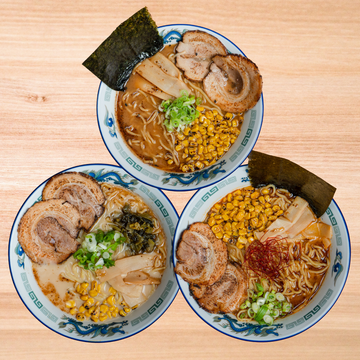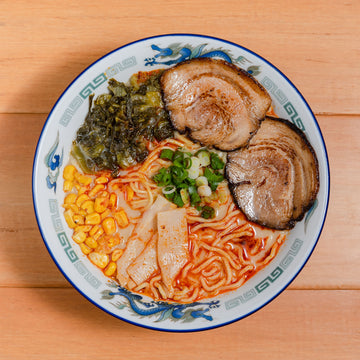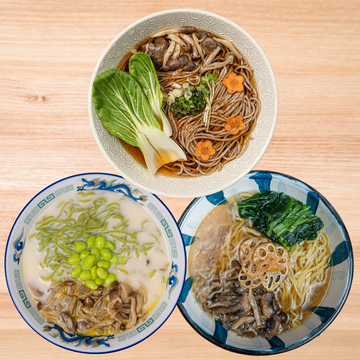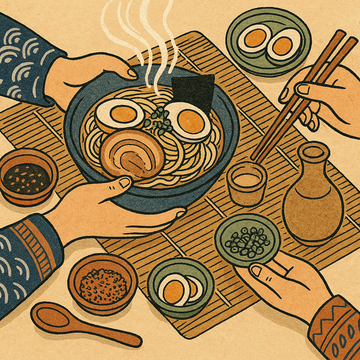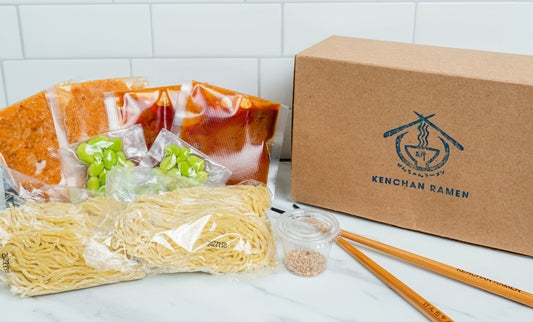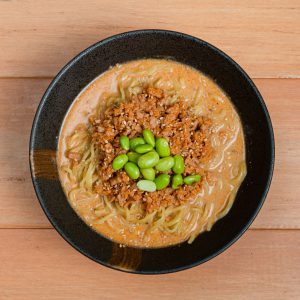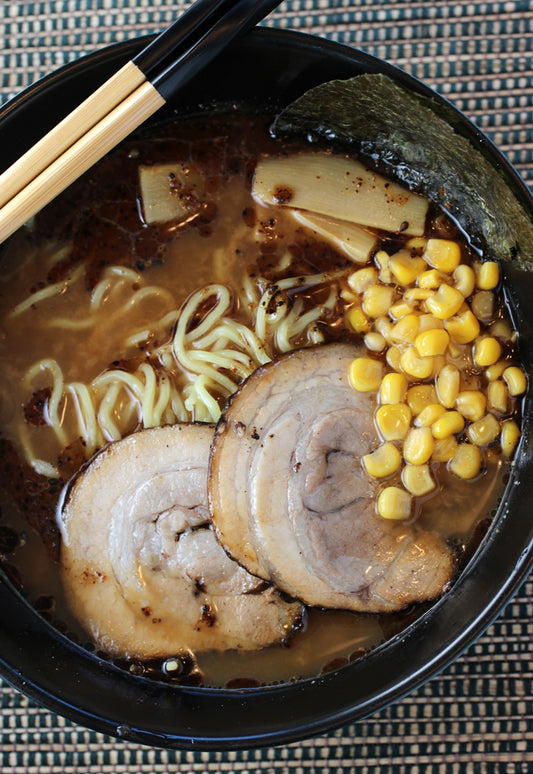Press
Share information about your brand with your customers. Describe a product, make announcements, or welcome customers to your store.
Press
Vegan & Gluten-Friendly Ramen at Home
How We Made the Impossible Bowl Possible
When we first started selling at farmers markets, one request came up constantly.Do you have gluten free ramen?
People were not asking out of curiosity. They were asking because they missed ramen. Celiac customers. Gluten sensitive customers. Families trying to avoid wheat. They had tried what existed in the market and were disappointed. Thin broths. Artificial flavor. Noodles that fell apart.
That’s when it clicked. There was a gap worth solving. People weren’t asking for “diet ramen.” They wanted the same satisfaction and depth that makes traditional ramen so special.
So we built it.
Not gluten free ramen that tastes “good for GF.”Not vegan ramen that is “pretty good considering.”Ramen that stands on its own.
Rethinking Flavor from the Ground Up
Classic ramen relies on pork bones, chicken stock, and wheat flour noodles for depth and texture. Take those away and you’re rebuilding ramen from zero.
Our approach started with umami, using the same techniques Japanese chefs have relied on for generations:
Kombu for clean ocean flavor
Shiitake mushrooms for earthiness
Slow-roasted garlic, caramelized cabbage, and onions for natural sweetness
Real organic white truffle oil for richness
For the White Truffle Mushroom broth, we emulsify vegetables to achieve creamy texture. No dairy. No fillers. For the Ginger Garlic Shio, we focus on balance: light, aromatic, and refreshing, built from real ginger and roasted garlic with pure Japanese salt.No artificial flavorings. No powdered shortcuts.
The Noodle That Changed Everything
Photo caption 1: Partnering with third-generation noodle masters from Gifu, Japan (July 2023)
Video caption: Craft in motion. Gluten free ramen noodles being made in Japan. Kobayashi Noodle is the 1st certified gluten free factory in Japan.
Ramen is defined by its noodles. Texture matters. After hundreds of tests, we partnered with a third-generation noodle maker in Gifu, Japan who shares our obsession with texture.
Our frozen gluten free noodles have the same bounce and chew as wheat noodles, and most people can’t tell the difference. They’re made with premium Japanese rice flour and traditional noodle methods that preserve spring and slurp.
For our instant line, we use premium non GMO Japanese rice flour, air dried. Clean, light, springy noodles that cook in minutes without turning soggy.
When Even Non-Vegans Took Notice
We launched our vegan and gluten free kits quietly, expecting a niche following. Instead, they became best sellers at markets. Non-vegans started buying them simply because they tasted great.
They didn’t say, “This is good for gluten free.”They said, “This is the best vegan ramen we’ve ever had!!”
Serving Suggestions
White Truffle Mushroom • Sautéed garlic • Fresh green onions • protein of your choice!
Ginger Garlic Shio • Sautéed garlic • Green onions • Squeeze of yuzu or lemon
One Hundred Percent Soba • Serve chilled • Dip in our tsuyu soup base • Add wasabi and shredded nori
Our Vegan and Gluten Free Collection
Our Best Selling Gluten Free Bundle Bundle
Gluten Free White Truffle Mushroom Ramen Creamy vegetable broth with organic white truffle oil and roasted aromatics.Shop GF White Truffle
Ginger Garlic Shio RamenLight and aromatic, made from roasted garlic, fresh ginger, and mineral salt.Shop GF Ginger Garlic Shio
Instant Shio Rice RamenNon-GMO rice noodles that are air-dried for spring and slurp. Ready in minutes.Shop Instant Shio Ramen
100% Buckwheat Soba and TsuyuSourced from Nagano, Japan. Pure buckwheat noodles with a kombu-shiitake tamari dipping sauce and Japanese spices.Shop 100% Soba
Here’s our whole vegan & gluten free collection
Why It Matters
We built this line because everyone deserves ramen that tastes real. Not “healthy ramen.” Not “good for gluten free.” Just ramen that satisfies.
It’s made with the same care, technique, and obsession we bring to every bowl—from the farmers market to your kitchen.
Experience what vegan and gluten free ramen should taste like.
Order your Kenchan Ramen vegan and gluten free kits hereStart with the bowl that changed how ramen can feel.
Master Chef Keizo Shimamoto's Newest Creation: Ramen Kit Delivered.
This limited-edition Niboshi Shoyu Ramen kit is an exclusive collaboration with the acclaimed Japanese-American chef, Keizo Shimamoto.
Chef Shimamoto is a renowned culinary innovator, recognized globally as the inventor of the world-famous Ramen Burger, which was featured by media outlets like CNN. His expertise in traditional ramen was showcased at his restaurant, Ramen Shack, which earned high praise from critics, including the Los Angeles Times.
Following the closure of Ramen Shack, this collaboration offers the public an exclusive opportunity to experience the mastery of this acclaimed chef. This kit features Chef Keizo’s signature complex niboshi (sardine) broth and specialized, thin handcrafted noodles.
The Ultimate Ramen & Sake Pairing Guide
A comprehensive overview of ramen and how to pair it with different types of sake. We cover the history of ramen, its key components like broth and noodles, and popular regional variations such as miso, shio, tonkotsu, and shoyu ramen. We suggest a specific sake pairing for each type of ramen based on their characteristics.
Ramen vs Udon vs Soba
When it comes to Japanese noodles, the three most notable are ramen, udon, and soba. Each of these noodles has its own unique characteristics, ingredients, and history that have helped shape Japanese food culture and influence cuisines around the world.
Ramen is perhaps the most popular of the three, known for its rich broth and chewy noodles. The key ingredients in ramen include wheat flour, water, salt, and kansui, an alkaline mineral water that gives the noodles their signature springy texture. Ramen broth can vary from pork-based tonkotsu to clear shoyu or miso broths, each with its own distinct flavor profile.
Toppings like chashu (roasted/braised pork), soft-boiled eggs, nori (seaweed), and green onions add depth and complexity to the dish. Ramen has a long history in Japan, with its origins dating back to the late 19th century. Chinese immigrants introduced wheat noodles to Japan, which eventually led to the creation of ramen as we know it today. Ramen shops quickly gained popularity in Japan, offering a warm and comforting meal that was affordable and satisfying.
Ramen became a staple in Japanese diets, especially during the cold winter months. Ramen has undoubtedly become the most popular internationally, with tonkotsu (pork bone) broth leading the way and even some tsukemen dipping style varieties from leading chain shops now gaining traction in the US and other countries over the last decade. Notable shops in the LA area include Tsujita, Daikokuya, and Shin Sen Gumi.
Udon noodles, on the other hand, are much thicker and chewier than ramen noodles, made with just wheat flour, water, and salt. These noodles are typically served in a clear dashi broth, made from kombu (dried kelp) and katsuobushi (dried bonito flakes), giving the dish a light and umami-rich flavor. Toppings for udon can vary but often include tempura, green onions, and kamaboko (fish cake). Udon noodles have been a part of Japanese cuisine for centuries, with origins dating back to the Nara period (710-794). The noodles were first introduced to Japan byBuddhist monks from China, who believed that the thick noodles would help them stay full and satiated during long periods of fasting. Udon noodles quickly gained popularity in Japan, becoming a staple in households and restaurants across the country.
Udon is also a vegan friendly noodle because unlike ramen, eggs are not used in their production. Not as many shops in the LA area specialize in Udon, but notable ones that do include Musashiya and Marugame Monzo.
Soba noodles, perhaps the healthiest and nutrient-dense of the three varieties, is made from buckwheat flour, water, and sometimes wheat flour. They are thinner and more delicate than udon noodles. The nutty and earthy flavor of buckwheat gives soba noodles a unique taste that pairs well with toppings like tempura, green onions, and nori. Soba noodles have a long history in Japan, dating back to the Edo period (1603-1868). Soba noodles were originally considered a luxury food reserved for special occasions, as buckwheat was an expensive and labor-intensive crop to cultivate. However, as the cultivation of buckwheat became more widespread, sobanoodles became more accessible and eventually became a common dish in Japanese households. Most soba is made with a blend of wheat and buckwheat, with 100% buckwheat varieties being somewhat rare. The ratio of the blend and the flavor profile of the tsuyu means even small differences during preparation can profoundly change the resulting flavors and textures. If you enjoy dipping your noodles and quickly slurping them, soba is the dish you're looking for. Notable shops specializing in soba around Los Angeles include Ichimiann and Otafuku.
Each of these noodle types has played a significant role in shaping Japanese food culture and influencing cuisines around the world. Ramen, with its rich and flavorful broths, has become a global phenomenon, with ramen shops popping up in cities around the world. Udon, with its simple yet satisfying flavor, is a popular comfort food in Japan and beyond. Soba, with its delicate flavor and versatile preparations, is a beloved dish for special occasions and everyday meals.
Kenchan began with an initial menu of ramen offerings that we have expanded over the last several years, and we are happy to announce upcoming product lines featuring Udon and Soba noodles! These kits will be made with the same fresh, premium ingredients and attention to dietary restrictions that you've come to expect from us. Thanks for your continued patronage!
Unraveling the Origins of Shio, Shoyu, Miso, and Tonkotsu Ramen Varieties in Japan
From the simplicity of shio and the classic nature of shoyu to the umami-rich miso and the indulgent tonkotsu, each variety of ramen in Japan holds a unique story and flavor profile/character. Learn more about where each variety is from and what the flavor profile beholds!
Ramen Directory - Premium Miso Ramen from Kenchan Ramen
Open the box and you should have all the ingredients you need. This box got hooked up with an extra egg.
https://ramendirectory.com/premium-miso-ramen-from-kenchan-ramen/
Vegconomist - OMNIFoods and Kenchan Ramen Launch DIY Ramen Kits Featuring OMNI Ground Pork
Alt-protein brand OMNIFoods announces it is partnering with LA’s Kenchan Ramen to offer at-home, DIY vegan ramen kits to consumers in Arizona, California, Idaho, Nevada and Utah.
“I’m so excited to share my favorite comfort food and these new delicious vegan options so that you too can be a ramen chef at home”
Made to provide an authentic, at-home ramen experience, Kenchan Ramen’s plant-based options are now available for purchase online and include three varieties:
White Truffle Mushroom – Creamy veggie broth adn white truffle w/ spinach noodles, edamame and sauteed mushrooms, drizzled with truffle oil.
Ginger Garlic Shio – An umami-filled ginger & garlic soup base with fresh noodles, sauteed mushrooms, spinach, lotus root, and onion ginger oil.
Spicy Sesame – A spicy ramen with stir-fried OmniGround pork protein, fresh noodles, edamame, chili threads and sesame seeds.
https://vegconomist.com/gastronomy-food-service/omnifoods-kenchan-ramen-pork/
Nosh - Kenchan Ramen Teams up with OMNIFoods to Create Authentic At-Home Vegan Ramen Experience
OMNIFoods, makers of the 100% plant-based OMNIPork, have partnered with Kenchan Ramen to offer at-home, DIY ramen kits to consumers throughout Arizona, California, Idaho, Nevada and Utah. While most ramen broth on the market contains meat, Kenchan Ramen offers three extraordinary plant-based options, namely White Truffle Mushroom, Ginger Garlic Shio and Spicy Sesame featuring OMNI Ground, which can all be sent directly to homes.
https://www.nosh.com/food-wire/2022/kenchan-ramen-teams-up-with-omnifoods-to-create-authentic-at-home-vegan-ramen-experience/
Food Gal - RIGHTEOUS RAMEN KITS — STRAIGHT TO YOUR DOOR
Would you believe I made this at home in no time flat from a kit?
Who doesn’t love a hot, heaping bowl of ramen at this chilly time of year?
Of course, you can get your fill at any number of ramen restaurants around. But Kenchan Ramen offers a novel way to get your fix — with its ramen kits to make at home.
Kenshi Kobayashi and Chef Motoki Teranishi started Kenchan Ramen kits in Los Angeles in 2020 during the pandemic. They now ship their assorted kits to Arizona, California, Idaho, Nevada, and Utah.
And they are exceptional, as I found out when I tried samples recently.
Each kit comes complete with most everything you need to make two servings of ramen, along with instructions.
https://www.foodgal.com/tag/kenchan-ramen-kits/
